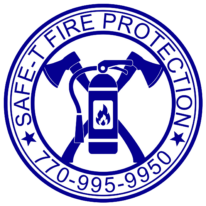Expert Emergency Lighting Services: Inspection, Testing, Repair, and Exit Lighting Installation Near You in Buford, GA
Emergency exit signs and lights lead people to safety. In times of distress, it’s normal to become disoriented and confused. Fires release toxic fumes, which lead people to panic in emergencies. LED emergency lighting creates a path for people to see where they need to go. Schedule emergency lighting testing and inspections to ensure your building is equipped in the event of an emergency.
CALL US 770-995-9950
Professional Fire Protection Services
At Safe-T Fire Protection, we’re committed to keeping your business safe with comprehensive fire protection services.
- Comprehensive Fire Inspections
- Fire Code Compliance
- Emergency Planning
- Fire Protection Systems
- 24/7 Emergency Service
Serving Buford, GA and surrounding areas with expert fire protection services.
Let Us Call You!
Expert Emergency Lighting Services: Inspection, Testing, and Exit Lighting Installation Near Buford, GA
Emergency lighting systems are vital for safeguarding occupants and ensuring compliance with safety regulations in any building. These systems provide critical illumination during emergencies such as power outages, fires, or evacuations, helping to guide people to safety and prevent accidents in dark or hazardous conditions. To ensure these systems perform optimally when needed most, regular maintenance is crucial. This includes comprehensive inspection and testing to identify potential issues, timely installation to meet building codes, and routine servicing to extend the life of the equipment.
Additionally, prompt repairs are necessary to address any malfunctions or damage that could compromise system performance. By prioritizing these measures, building owners and facility managers can enhance safety, reduce liability risks, and ensure regulatory compliance at all times. If you’re ready for emergency lighting services, contact our team today!
Comprehensive Emergency Lighting Inspections: Ensuring Readiness Near You in Buford, GA
Emergency lighting inspections are a critical first step in maintaining a reliable safety system that protects building occupants during power outages or emergencies. These thorough evaluations involve a detailed examination of all system components, such as light fixtures, batteries, control panels, and wiring connections. Our trained Safe-T Fire Protection technicians check for signs of wear, corrosion, damage, or loose connections that could compromise system functionality. Batteries are tested for capacity and charge retention to ensure they provide sufficient backup power when needed, while light fixtures are inspected for brightness and alignment to guarantee adequate illumination.
Our licensed professionals will also assess whether the system complies with all relevant safety standards, including the NFPA 101 Life Safety Code, OSHA requirements, and local building regulations. They verify proper placement of emergency lights in critical areas such as exit routes, stairwells, and corridors, ensuring full coverage and visibility. If any deficiencies or code violations are found, corrective actions are recommended to restore compliance and system reliability. If it’s time for a emergency lighting inspection, contact our Safe-T Fire Protection team, today!
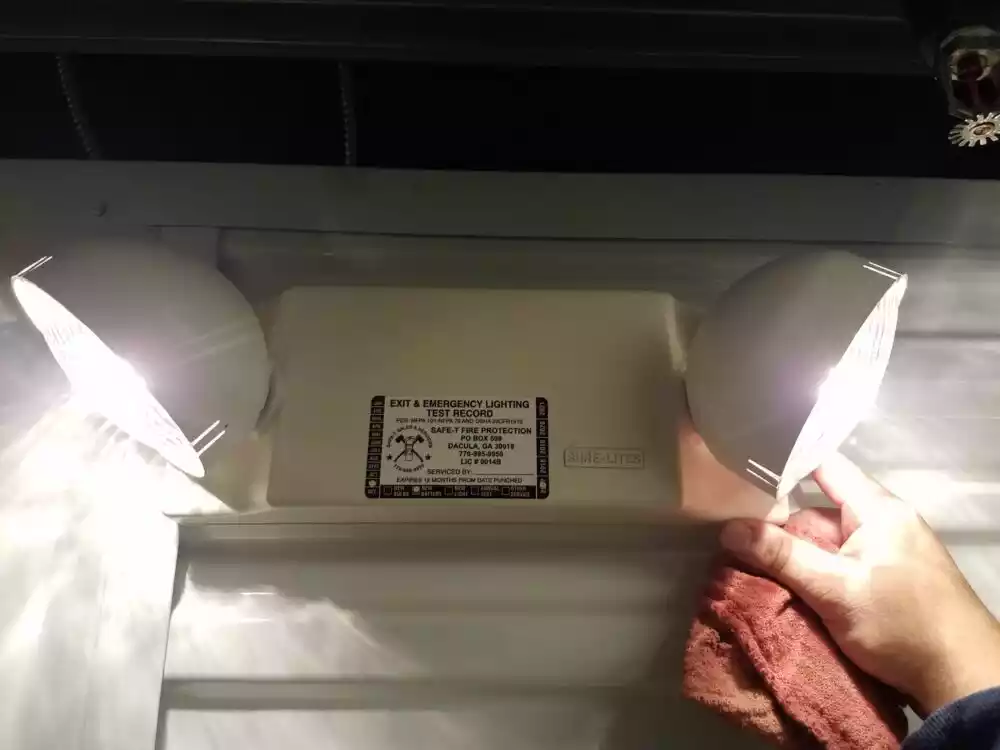
Critical Testing Protocols: Proving Performance Under Pressure Near You
Testing emergency lighting systems is vital to confirm their functionality in real-world scenarios. Monthly quick checks and annual full-duration tests, as required by safety codes, simulate emergency conditions to ensure systems provide at least 90 minutes of illumination. Trained technicians evaluate backup power supplies, perform simulated power outages, and verify the integrity of all components. Comprehensive testing protocols are meticulously documented, satisfying compliance requirements and preparing systems for unexpected challenges. Ready for a test? Get in touch today!
Strategic Installation: Setting the Foundation for Safety For Buford, GA Businesses
Proper installation is the foundation of an effective emergency lighting system, ensuring the safety and visibility of occupants during emergencies. Our certified Safe-T Fire Protection professionals begin by conducting a thorough assessment of the building’s layout, paying close attention to critical areas such as stairwells, corridors, exit routes, assembly points, and high-traffic zones.
Our trained technicians adhere to local building codes, fire safety guidelines, and national regulations to ensure full compliance. They strategically position emergency lights to eliminate blind spots and maximize visibility, helping to prevent confusion or panic during evacuations. The installation process also involves integrating the new lighting system with existing power supplies, control panels, and backup systems to enable seamless operation in the event of a power outage or emergency.
By prioritizing meticulous planning and precise execution, a properly installed emergency lighting system ensures every corner of the facility is well-lit during critical moments. This not only facilitates safe and efficient evacuations but also reduces the risks of accidents or injuries, providing occupants with a dependable safety net when it matters most. If you’re ready for emergency light installation, contact us today!
Reliable Emergency Light Maintenance: Preserving System Integrity Near Buford, GA
Routine maintenance is essential for keeping emergency lighting systems in peak condition and ensuring they function reliably during emergencies. This process typically includes a thorough cleaning of light fixtures to remove dust, debris, or grime that may reduce illumination levels. Our team will inspect wiring and connections to identify signs of wear, corrosion, or loose components that could cause failures. Aging or depleted batteries are replaced promptly to ensure backup power is available when needed. Additionally, outdated or faulty system components are upgraded or replaced to align with the latest technology and safety standards. If your emergency lights are in need of maintenance, get in touch today!
Expert Emergency Lighting Repairs: Restoring Confidence and Functionality to Your Buford, GA Business
Even the most durable and well-designed emergency lighting systems may experience issues over time, making swift and professional repairs crucial for maintaining safety and compliance. Our Safe-T Fire Protection team will play a key role in diagnosing a range of potential problems, including faulty wiring, corroded or damaged fixtures, worn-out bulbs, malfunctioning control panels, or depleted backup power sources such as batteries. Our expertise allows us to quickly identify the root cause of any malfunction and implement effective solutions to restore the system’s full functionality.
Beyond addressing immediate issues, repair services also adapt systems to evolving building layouts, such as renovations or expansions, ensuring adequate coverage in all areas. Additionally, they help bring systems up to date with the latest safety codes and industry standards, reducing the risk of non-compliance penalties. By ensuring emergency lighting systems are always operational and aligned with regulatory changes, prompt repairs minimize system downtime, enhance building safety, and reaffirm the system’s readiness to protect lives during emergencies. In need of emergency lighting repair? Contact our Safe-T Fire Protection team today!
Trust Us with Emergency Lighting Testing Near Buford, GA
Even emergency lighting with battery backup needs to be routinely tested to ensure that it works. If you don’t schedule emergency lighting testing, you could end up in a situation where the power goes out, and you need to get to the exit, but the emergency lights don’t come on. This would be a dire situation and, in emergencies, could lead to harsh injuries or death.
It’s important to schedule emergency lighting inspections to ensure that they will function when needed. Test for a minimum of 30 seconds every month and 90 minutes every year. Also, keep logs when you conduct emergency lighting testing so that you have evidence of your maintenance in case of a fire. If your emergency lights are in need of testing, get in touch today!
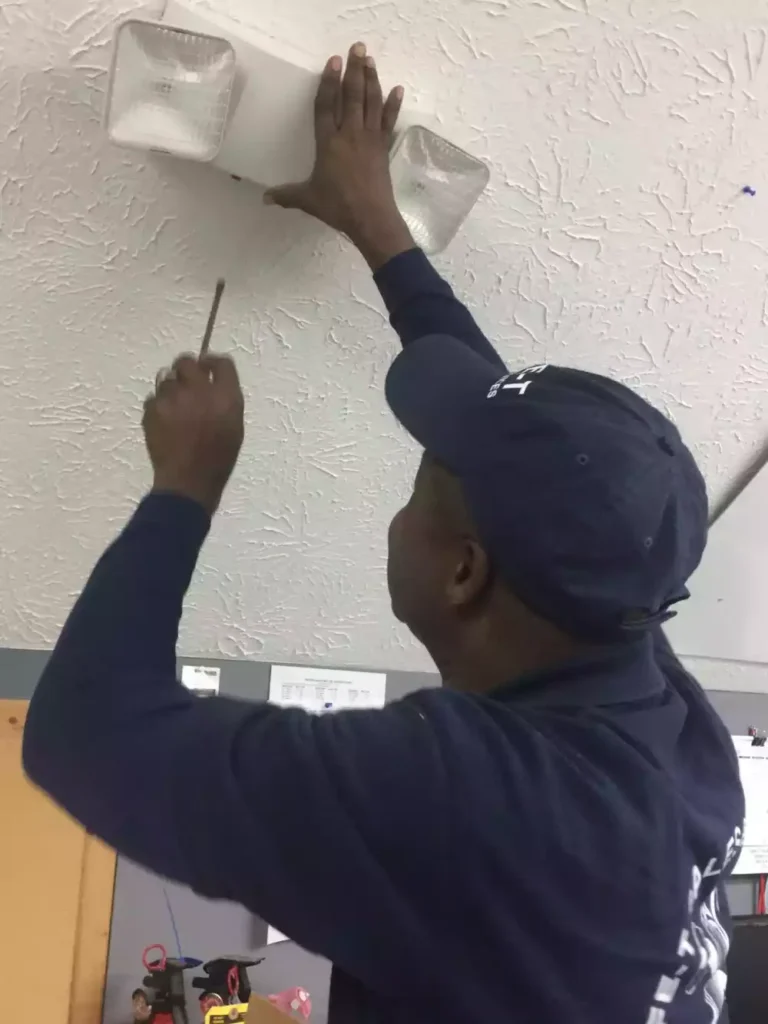
Types of Emergency Lighting We Offer Near You
Open Air Lighting: Open air lighting is a crucial safety feature for large venues like sports stadiums, arenas, and open event spaces. These environments require high-capacity emergency lighting systems to ensure effective guidance during evacuations. Open air lighting operates on power supplied by robust batteries or generators, providing consistent illumination even during extended power outages.
Exit Sign & Escape Route Lighting: Exit sign and escape route lighting are vital for guiding occupants to safety during emergencies. These systems feature illuminated signs that clearly indicate exit points and directional lights that lead to them. Common in venues like movie theaters, shopping malls, and office buildings, exit lighting is carefully positioned to be easily visible, often near ceilings or along walls.
High-Risk Lighting: High-risk lighting is a powerful emergency lighting system designed for high-stakes environments, such as large manufacturing facilities, chemical plants, and hazardous industrial sites. These systems provide bright, focused illumination to critical areas, enabling workers to address emergencies, shut down equipment, or evacuate safely.
Battery Back-Up Lighting: Battery back-up lighting is designed to provide dependable illumination during power outages, ensuring safety and functionality in critical facilities. Found in places like hospitals, fire stations, and essential service centers, these lights automatically switch to battery or generator power when the primary source fails.
Types of Illumination Lights We Offer Near You
Fluorescent: A Traditional Choice with Versatility
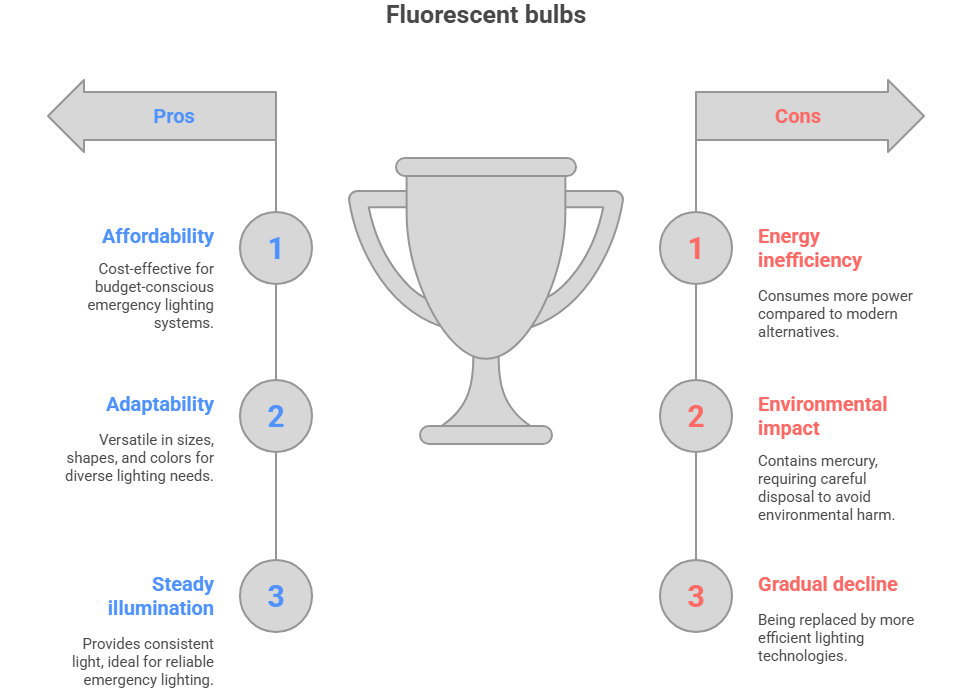
Fluorescent bulbs have been a longstanding choice for emergency lighting systems due to their affordability and adaptability. Available in a range of sizes, shapes, and colors, these bulbs can be tailored to various lighting needs, making them a popular option in the past. However, their energy efficiency and environmental impact have become a growing concern.
Traditional fluorescent bulbs consume more power than modern alternatives and contain small amounts of mercury, requiring careful disposal to prevent environmental harm.
Despite these drawbacks, fluorescent lighting remains a viable option for applications where cost is a priority, especially in systems that don’t require extended usage or frequent replacements. Their ability to provide steady illumination has made them a staple in many facilities, though advancements in lighting technology have gradually reduced their prevalence.
LED: The Modern Standard for Efficiency and Sustainability
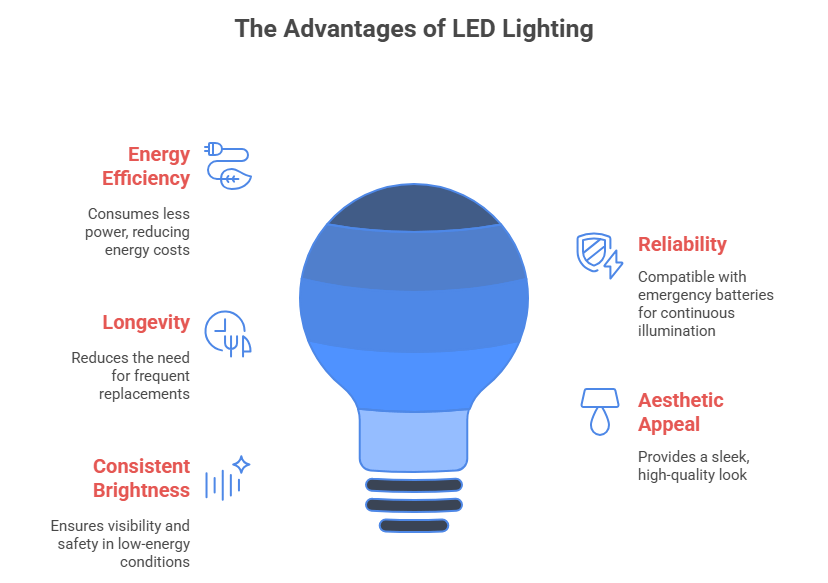
LED lighting has rapidly become the go-to option for emergency lighting systems, offering a host of benefits over traditional alternatives. These energy-efficient bulbs consume significantly less power, making them an eco-friendly choice that can help lower energy costs. Their compatibility with emergency batteries enhances reliability, ensuring continuous illumination during outages.
LED bulbs are also known for their longevity, reducing the need for frequent replacements and further contributing to cost savings. Beyond their practicality, LED lights provide a sleek, high-quality aesthetic that aligns with modern design trends, making them a preferred choice in new installations. Their ability to deliver consistent brightness, even in low-energy conditions, ensures visibility and safety when it matters most. With increasing focus on sustainability and efficiency, LED lighting continues to lead the way as a superior solution for emergency and everyday lighting needs.
Let Safe-T Fire Protection perform your commercial emergency lighting service today. Our team is well-trained in providing the most thorough, detailed services that will guarantee your emergency lighting and exit signs are working properly to keep everyone safe.
Schedule Your Emergency Lighting Service Today Near Buford, GA
If it’s been over a year since your last emergency lighting inspection, now is the time to act. Contact Safe-T Fire Protection to schedule your appointment and ensure your systems are ready to perform when it matters most. Partnering with a professional fire protection company is essential to comply with safety regulations and maintain the reliability of your emergency lighting. Annual testing by licensed technicians ensures every component is functioning correctly and ready for an emergency.
When Miller Veterinary Services hired us for their Safe-T Fire Protection service, they had this to say: “Thank you so much Travis Spencer for coming out so quickly to help us check on all of our equipment! You were so thorough and double-checked everything and we really appreciate it. We have precious lives to protect! Thank you again! Miller Veterinary Services, Conyers, GA”
Learn more on our blog about staying safe during a fire or emergency! Don’t wait for an incident to highlight vulnerabilities—be proactive. Schedule your fire safety services today to protect your employees, property, and peace of mind.
Do I really need emergency lighting for my Buford, GA business?
Yes! Emergency lighting and exit signs will lead people out of the building during a fire. Smoke and chaos can make it difficult to think straight, and emergency lighting is a beacon that leads people out of the building. That’s why emergency lighting testing and inspections are vital to ensure your building is ready in the event of a fire. Contact our team today to get started!
Will emergency lights work if the electricity goes out?
All emergency lighting must have some sort of backup power. This could be batteries, a generator, or another power system. If electricity fails, the backup power must provide enough light to lead people out of the building. Schedule regular emergency lighting inspections to ensure you’re ready in case of a power outage.
How long will emergency lighting last?
When activated during an emergency, a good emergency light will last 90 minutes. Emergency light batteries can last up to 5 years. You should have emergency lighting inspections and testing annually to determine that the batteries are fully charged. If it’s time for your inspection or maintenance, contact us today!
What is the difference between emergency lighting and exit lights?
Exit lights are the signs that read “EXIT,” while emergency lights illuminate the pathway leading to the exit. Both are required to be installed at your place of business. If you are in need of one or the other, get in touch today!
Areas We Serve Near You For Emergency Lighting Services
- Acworth, GA
- Alpharetta, GA
- Athens, GA
- Atlanta, GA
- Atlantic Station, GA
- Auburn, GA
- Austell, GA
- Avondale Estates, GA
- Ball Ground, GA
- Berkeley Lake, GA
- Bethlehem, GA
- Big Creek, GA
- Bogart, GA
- Braselton, GA
- Brookhaven, GA
- Buford, GA
- Canton, GA
- Chamblee, GA
- Chestatee, GA
- Chestnut Mountain, GA
- Clarkston, GA
- Clermont, GA
- Cleveland, GA
- Coal Mountain, GA
- Commerce, GA
- Cornelia, GA
- Crabapple, GA
- Cumming, GA
- Dacula, GA
- Dahlonega, GA
- Dallas, GA
- Decatur, GA
- Doraville, GA
- Druid Hills, GA
- Duluth, GA
- Dunwoody, GA
- East Cobb, GA
- Fair Oaks, GA
- Flowery Branch, GA
- Gainesville, GA
- Gillsville, GA
- Grayson, GA
- Hickory Flat, GA
- Holly Springs, GA
- Homer, GA
- Hoschton, GA
- Jefferson, GA
- Jasper, GA
- Johns Creek, GA
- Kennesaw, GA
- Lawrenceville, GA
- Lilburn, GA
- Lithia Springs, GA
- Lithonia, GA
- Loganville, GA
- Lula, GA
- Mableton, GA
- Marietta, GA
- Maysville, GA
- Midtown, GA
- Monroe, GA
- Mountain Park, GA
- Murrayville, GA
- Nicholson, GA
- Norcross, GA
- North Decatur, GA
- North Druid Hills, GA
- North Fulton, GA
- Oakwood, GA
- Peachtree City, GA
- Peachtree Corners, GA
- Pendergrass, GA
- Pine Lake, GA
- Powder Springs, GA
- Redan, GA
- Rest Haven, GA
- Roswell, GA
- Sandy Plains, GA
- Sandy Springs, GA
- Scottdale, GA
- Silver City, GA
- Smyrna, GA
- Snellville, GA
- Southern Oaks, GA
- Statham, GA
- Stone Mountain, GA
- Sugar Hill, GA
- Suwanee, GA
- Talmo, GA
- Tucker, GA
- Tuxedo Park, GA
- Vining, GA
- Waleska, GA
- Watkinsville, GA
- Winder, GA
- Woodstock, GA
